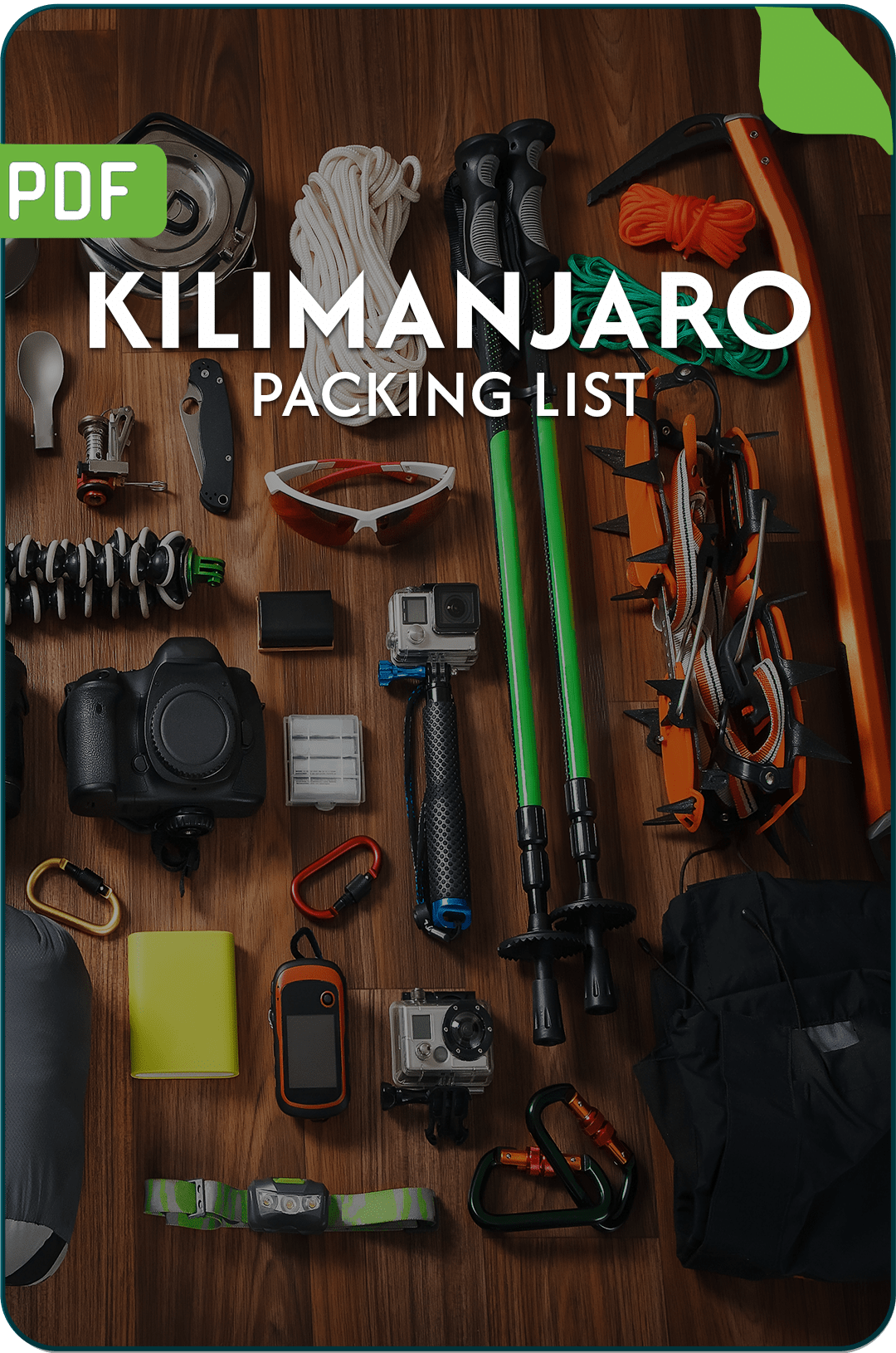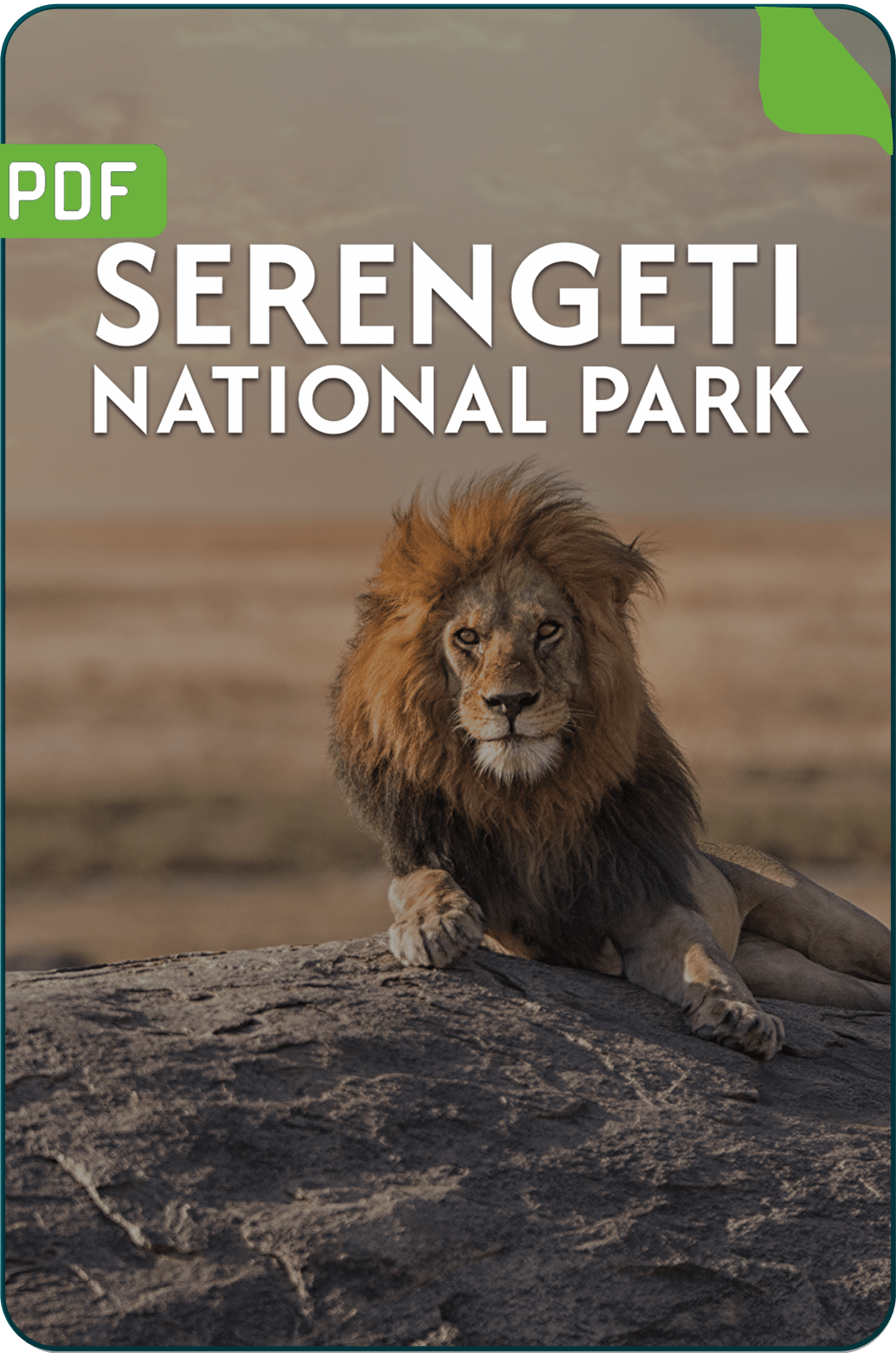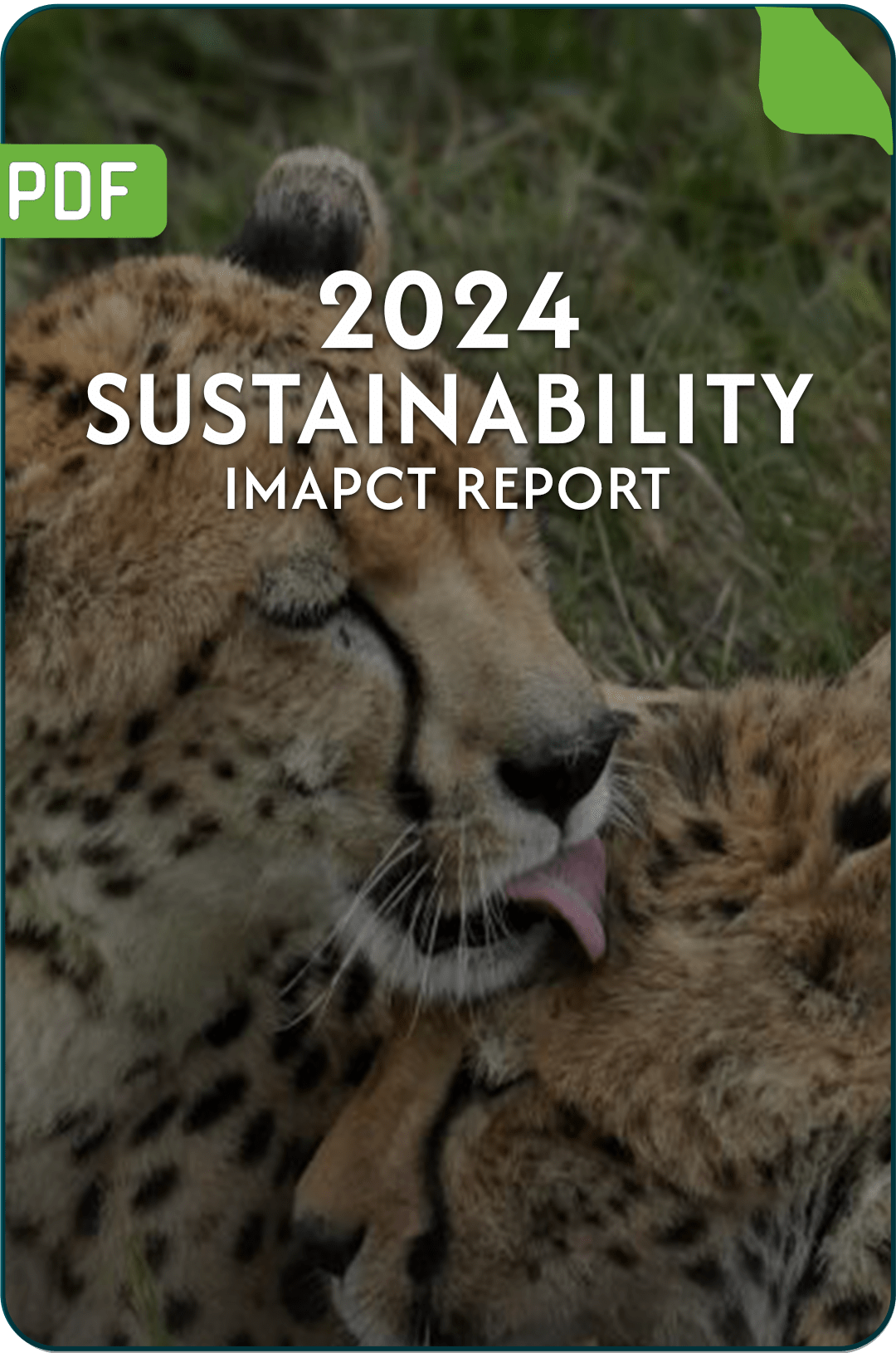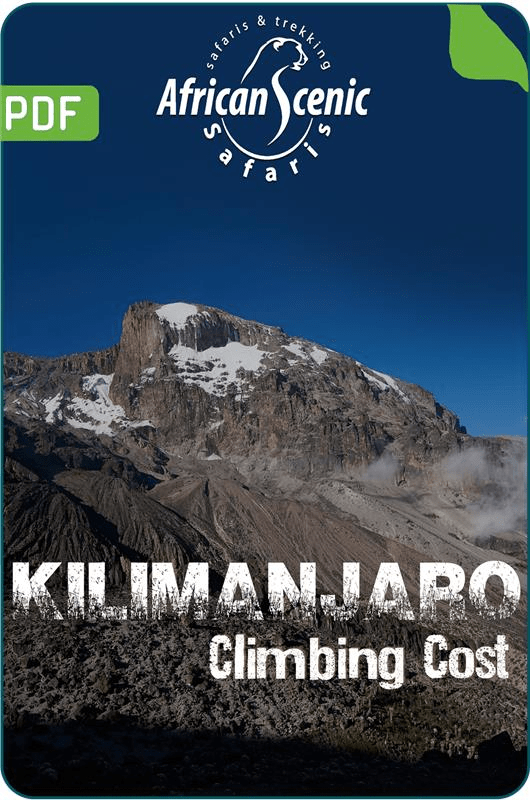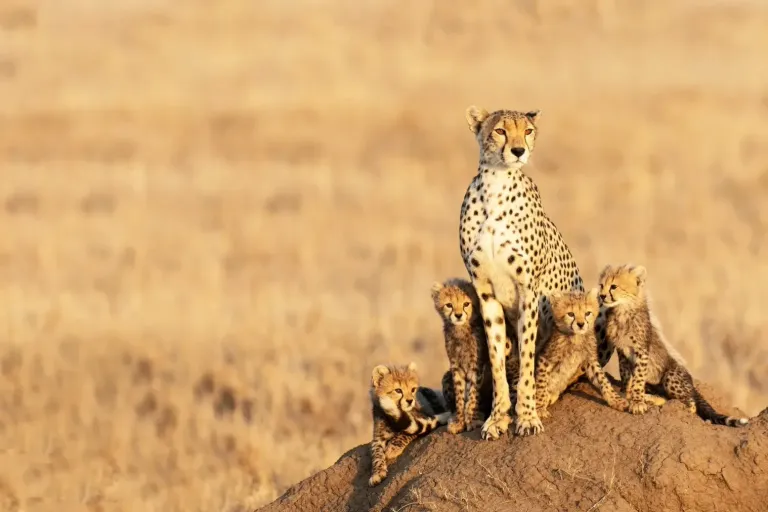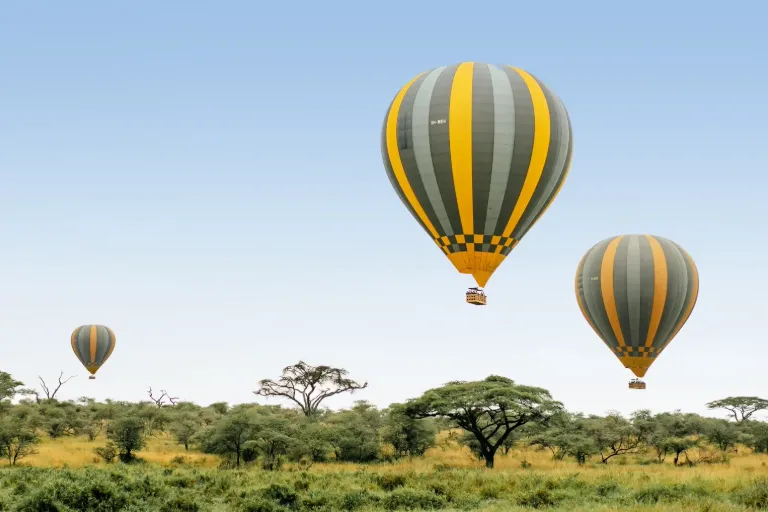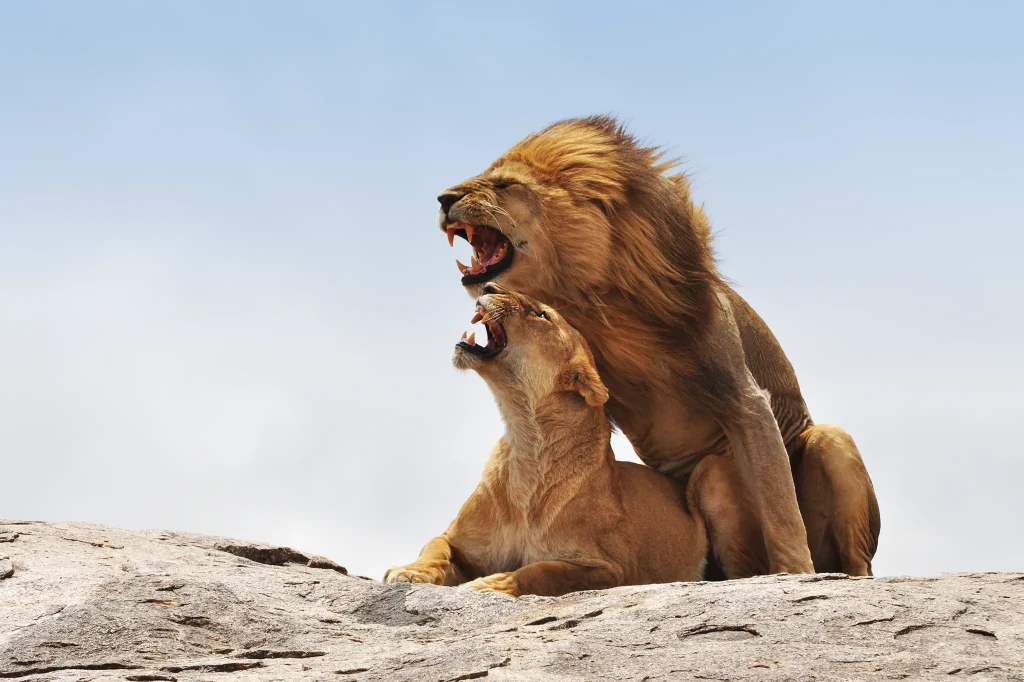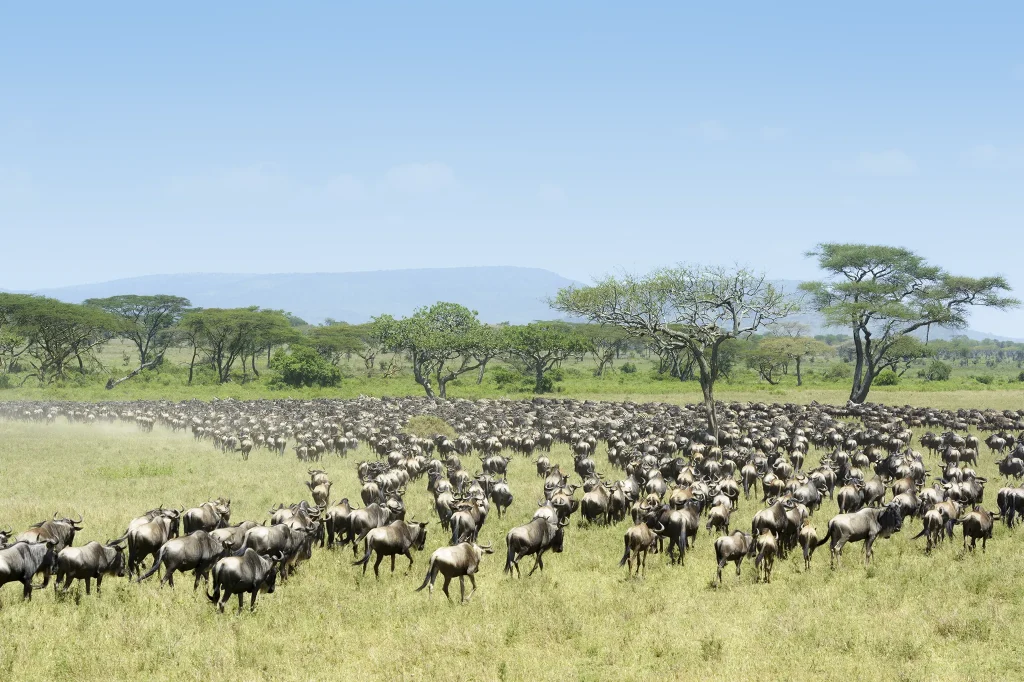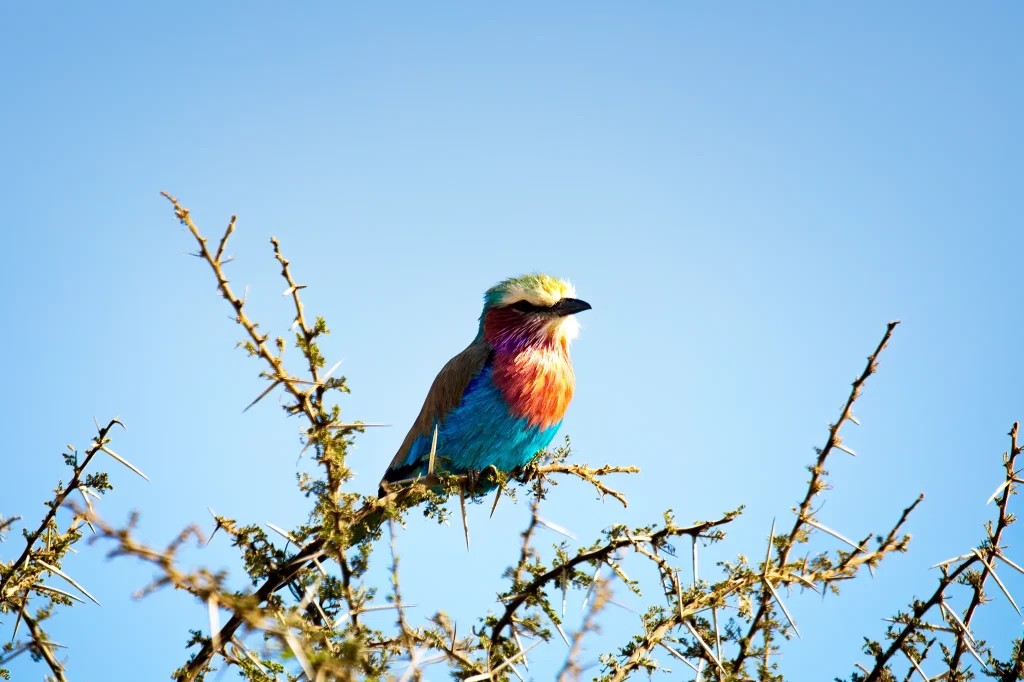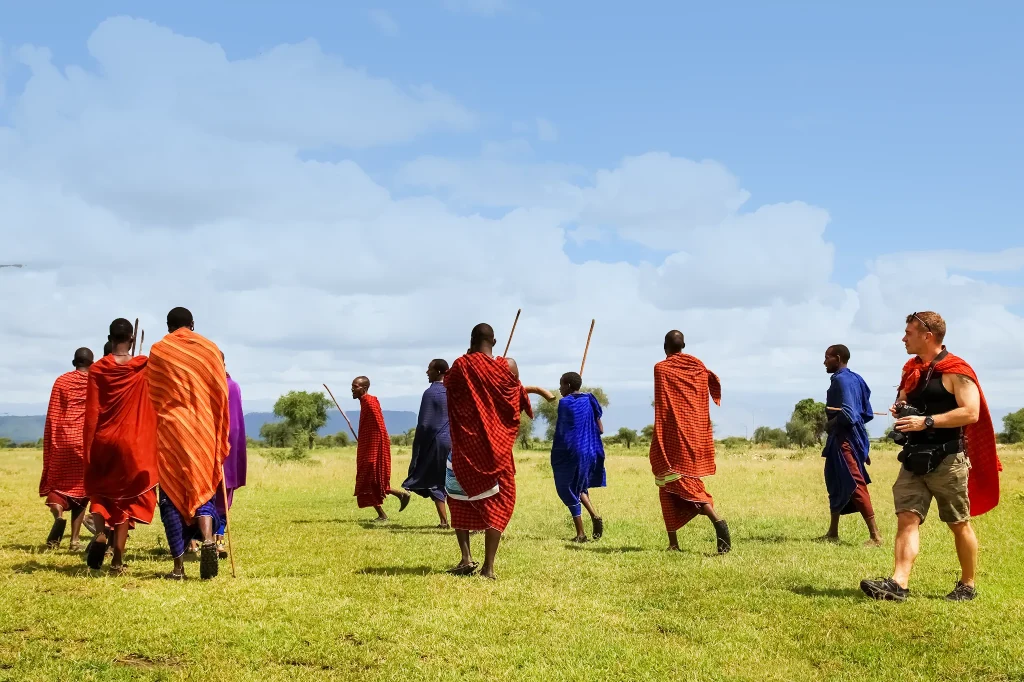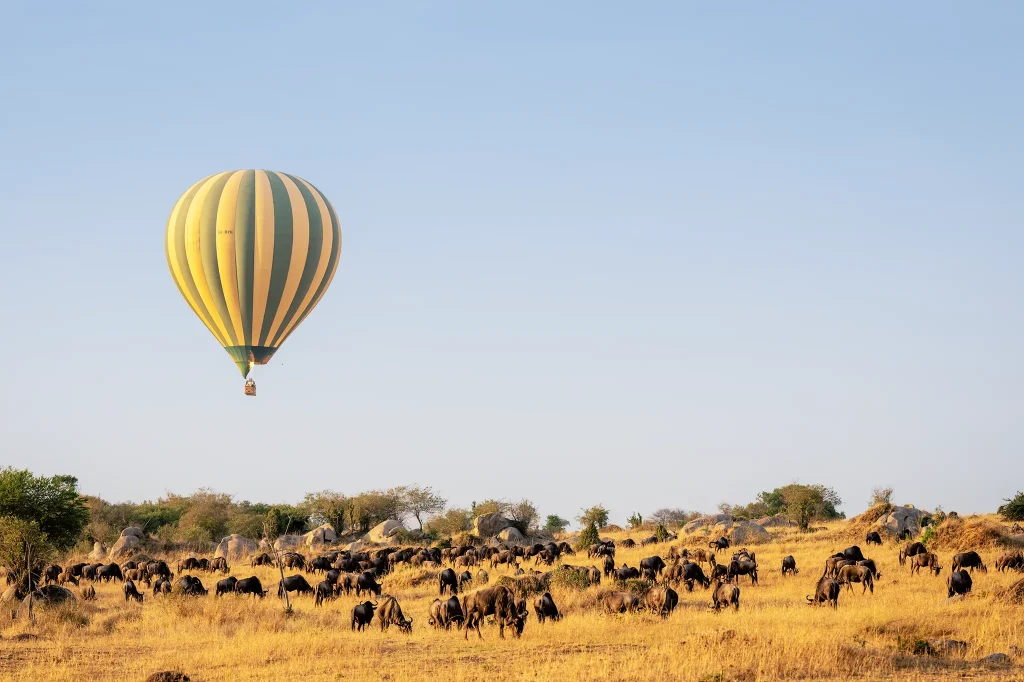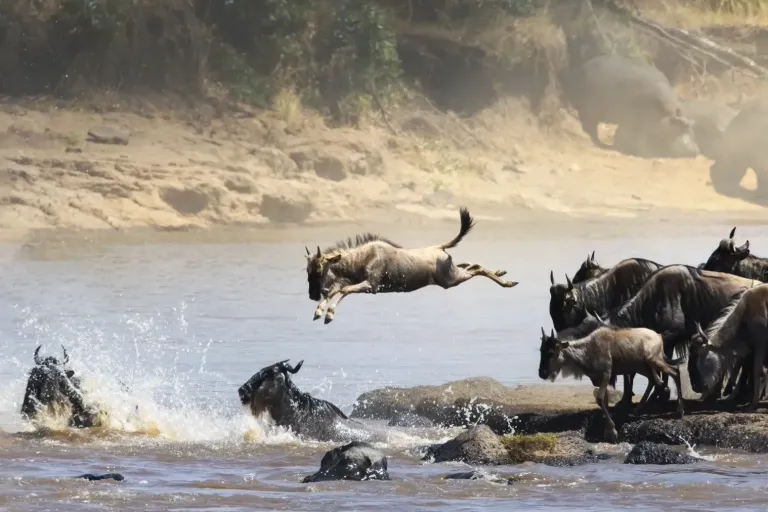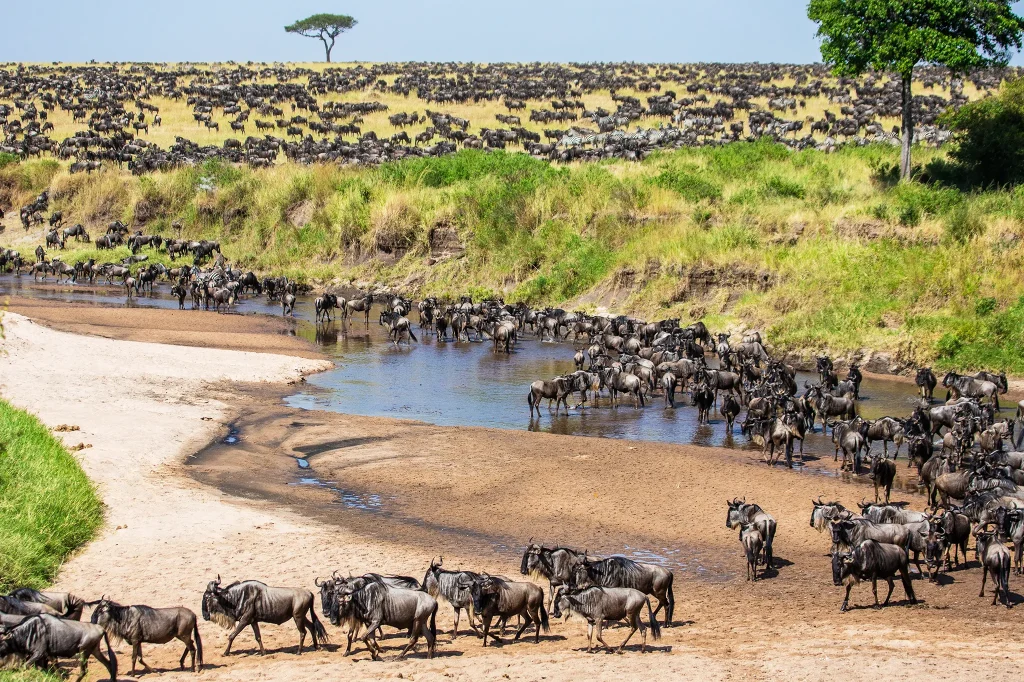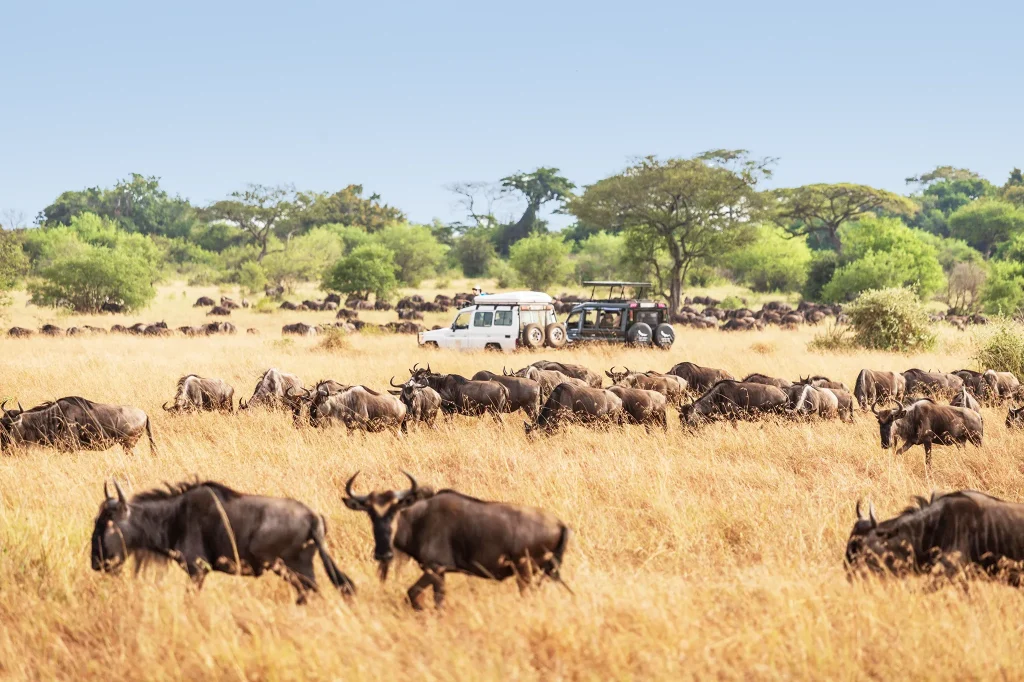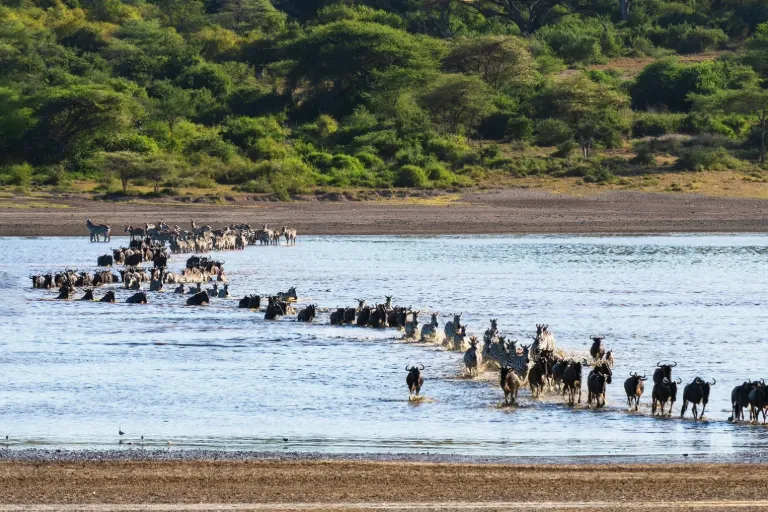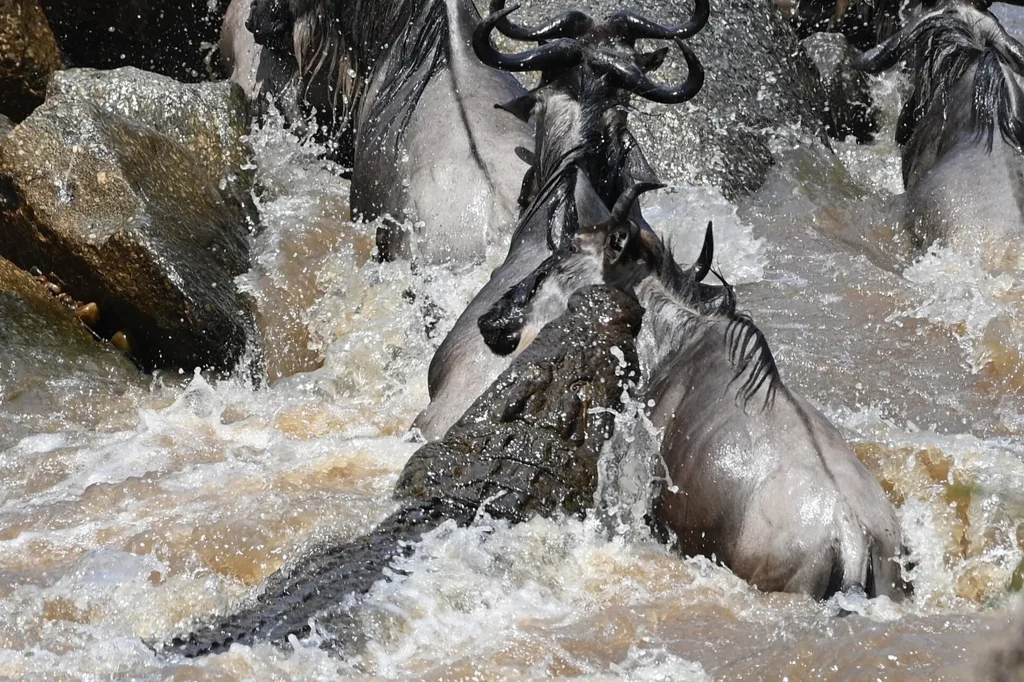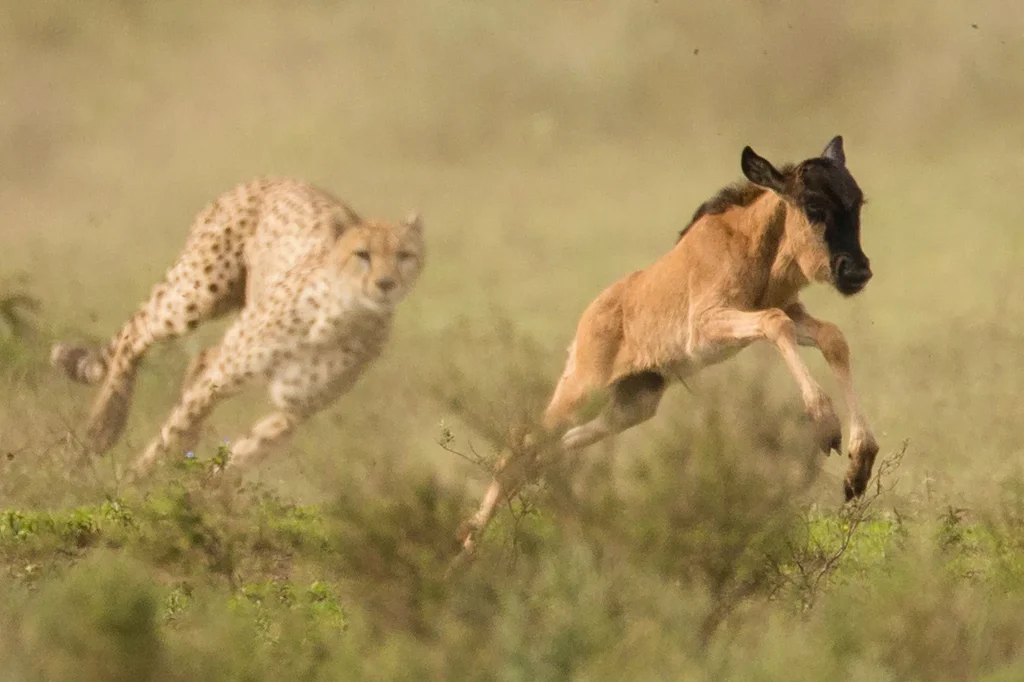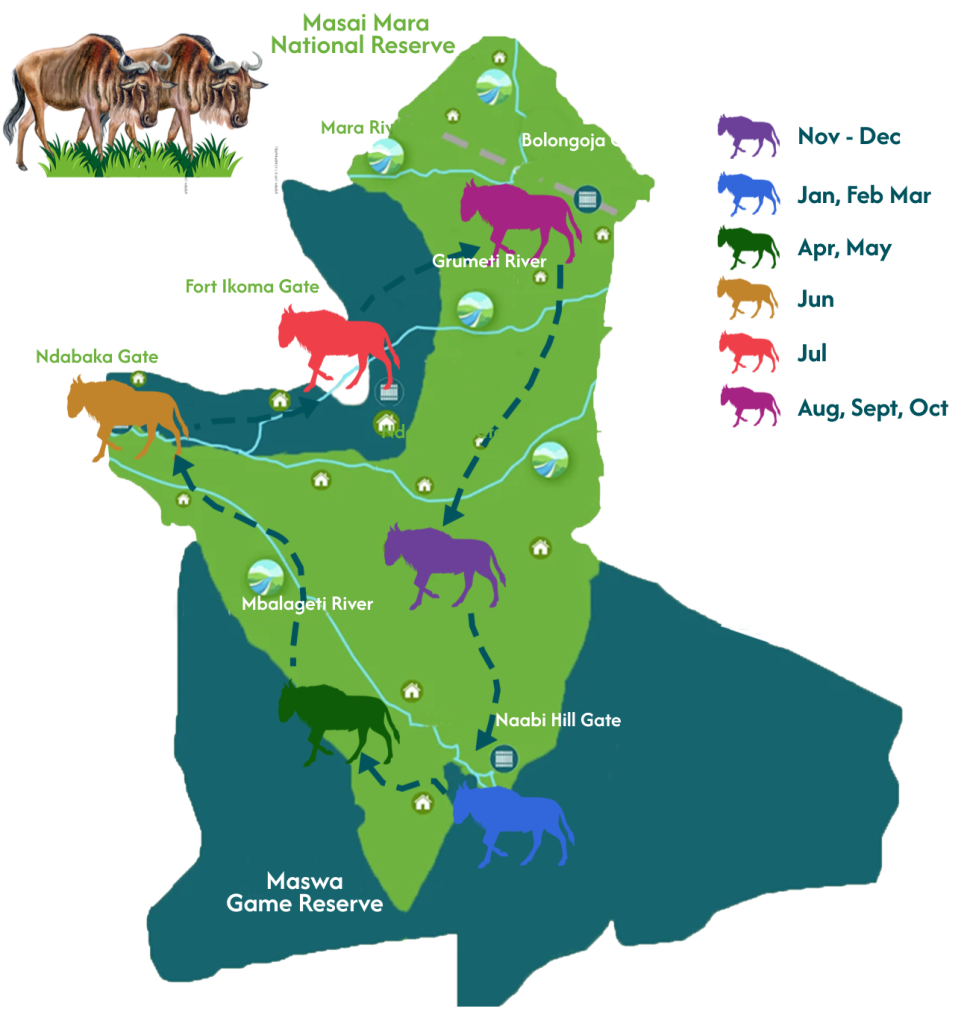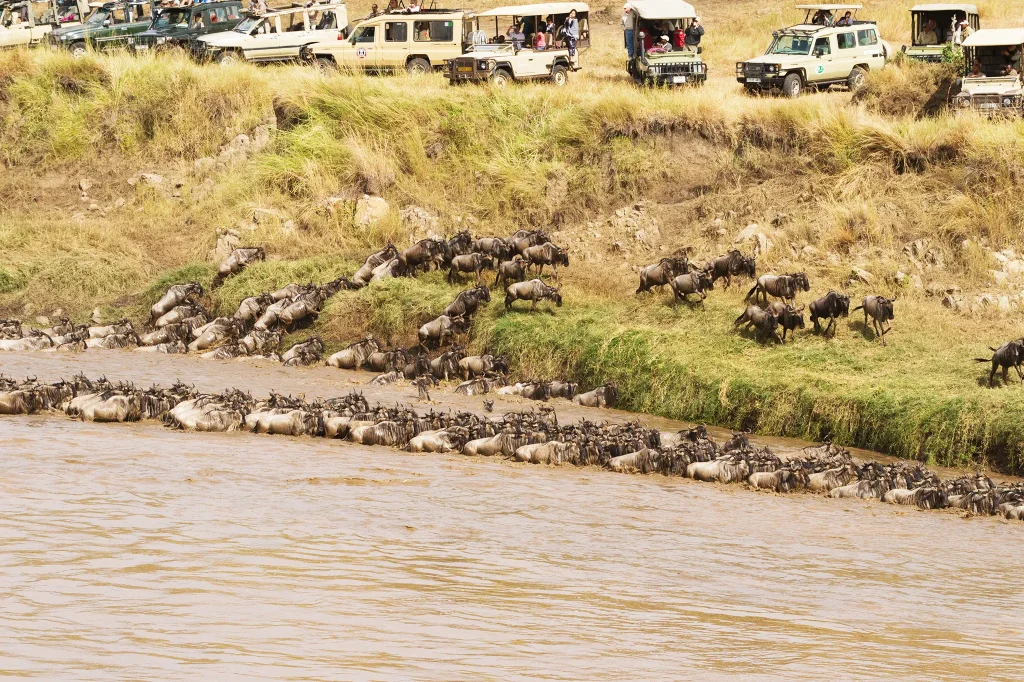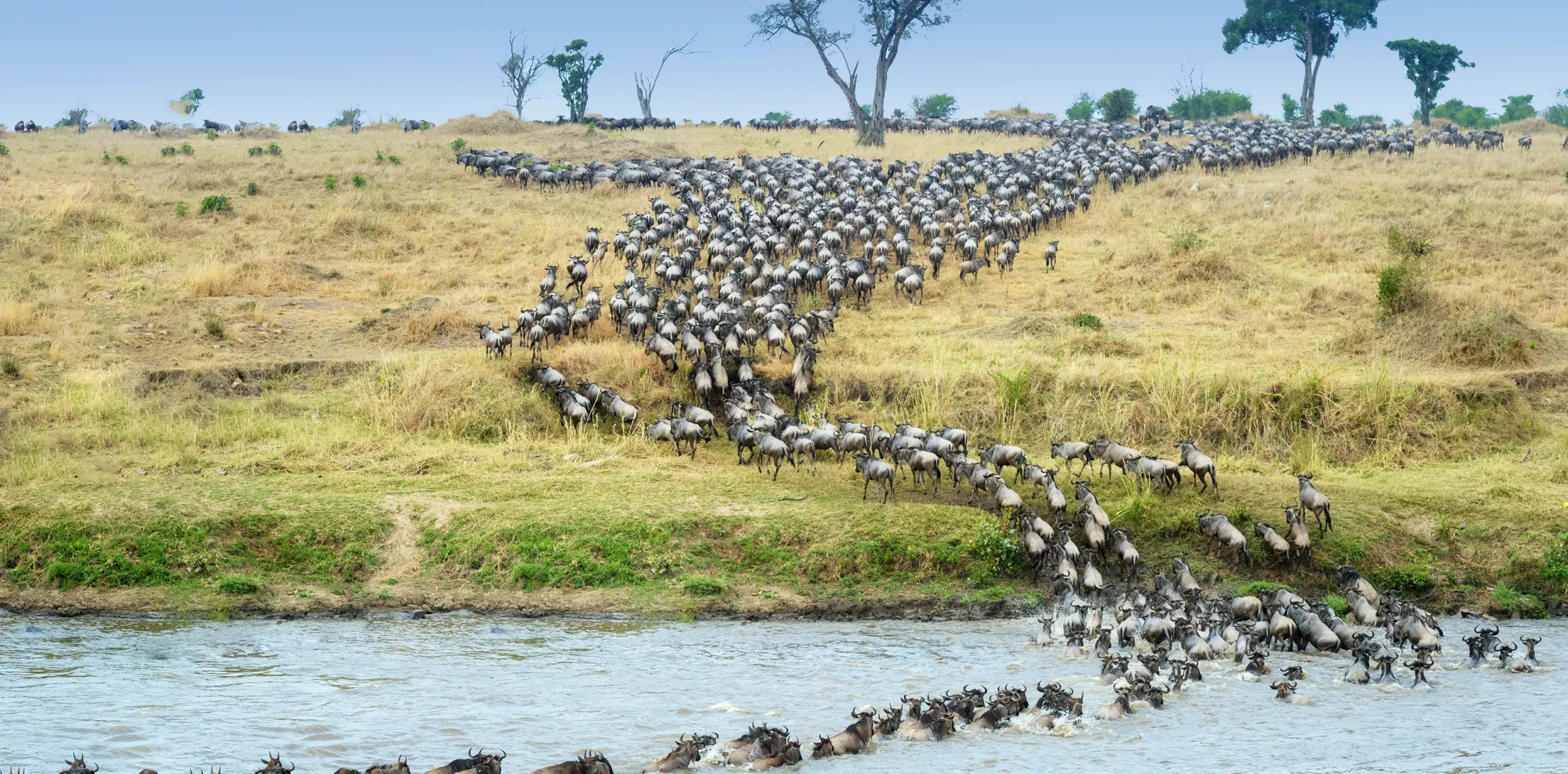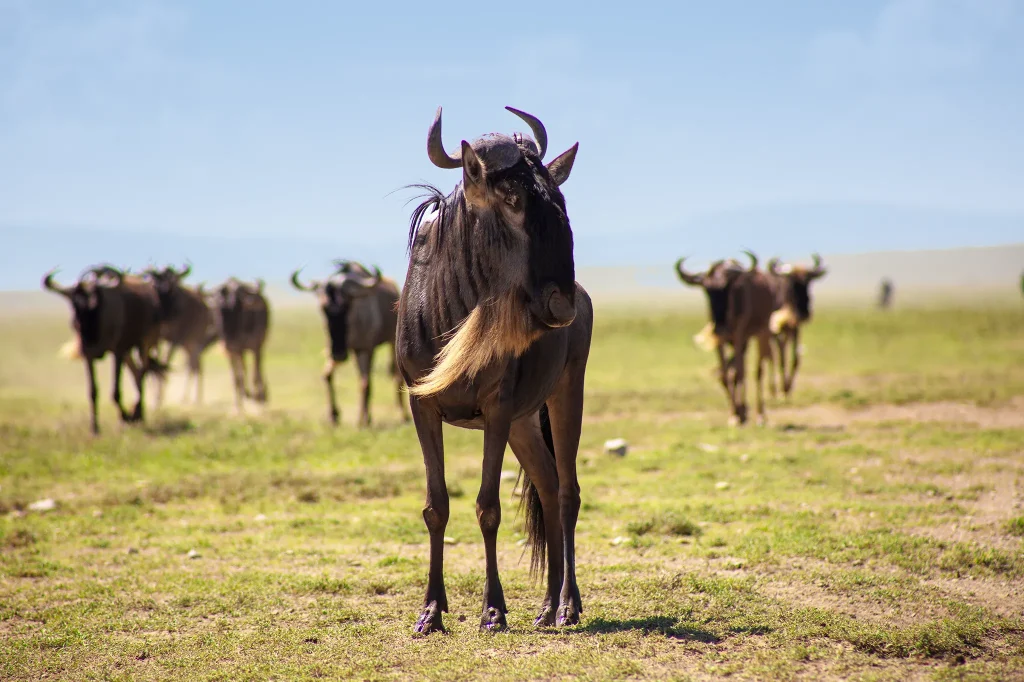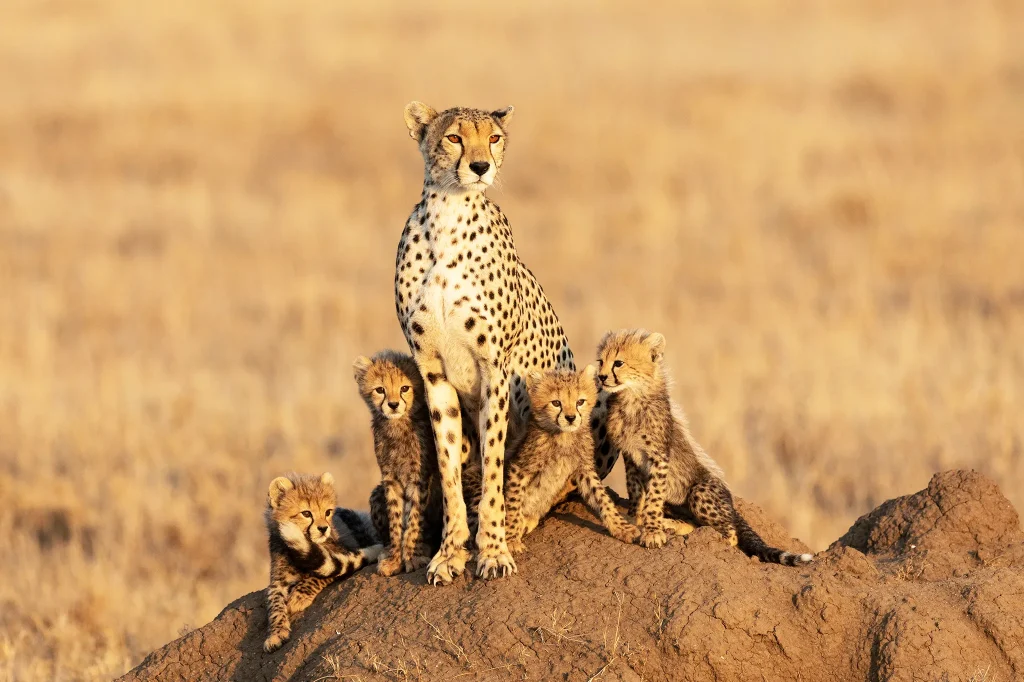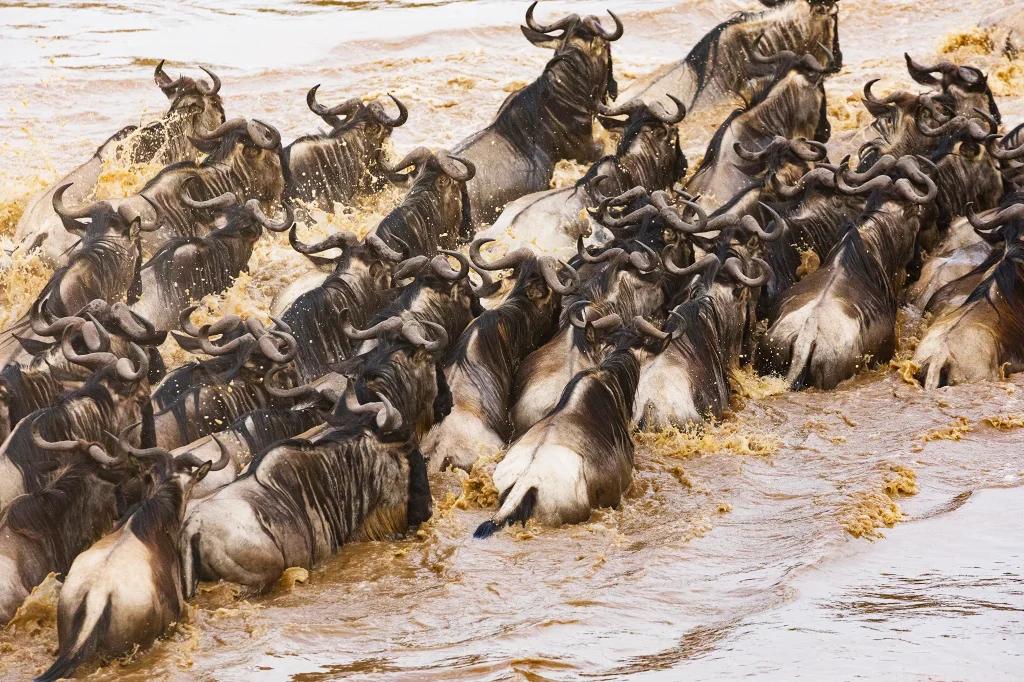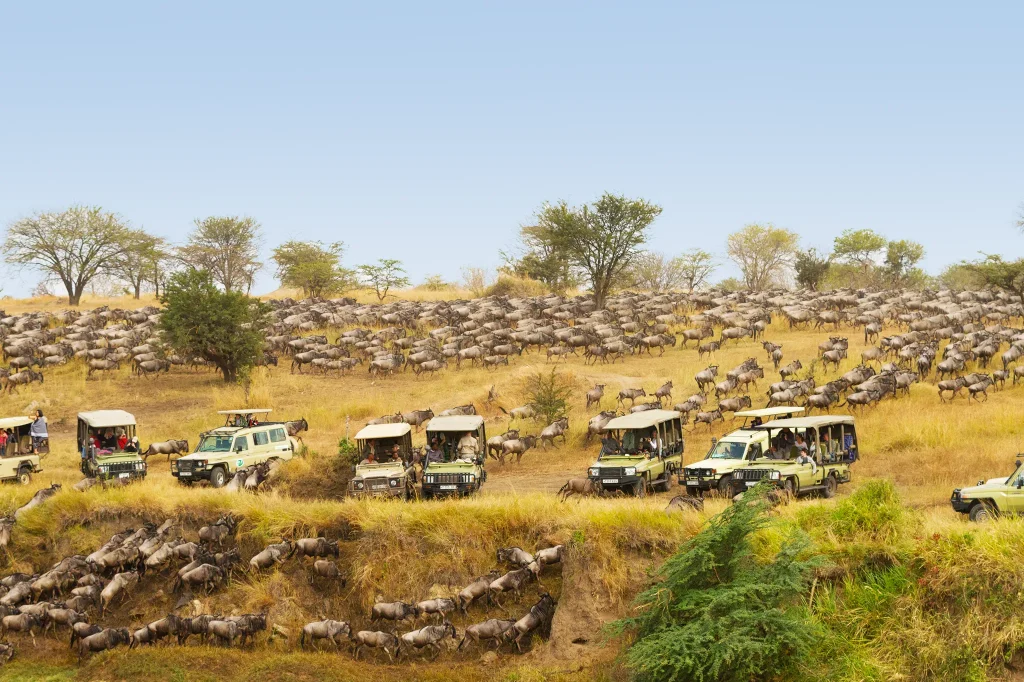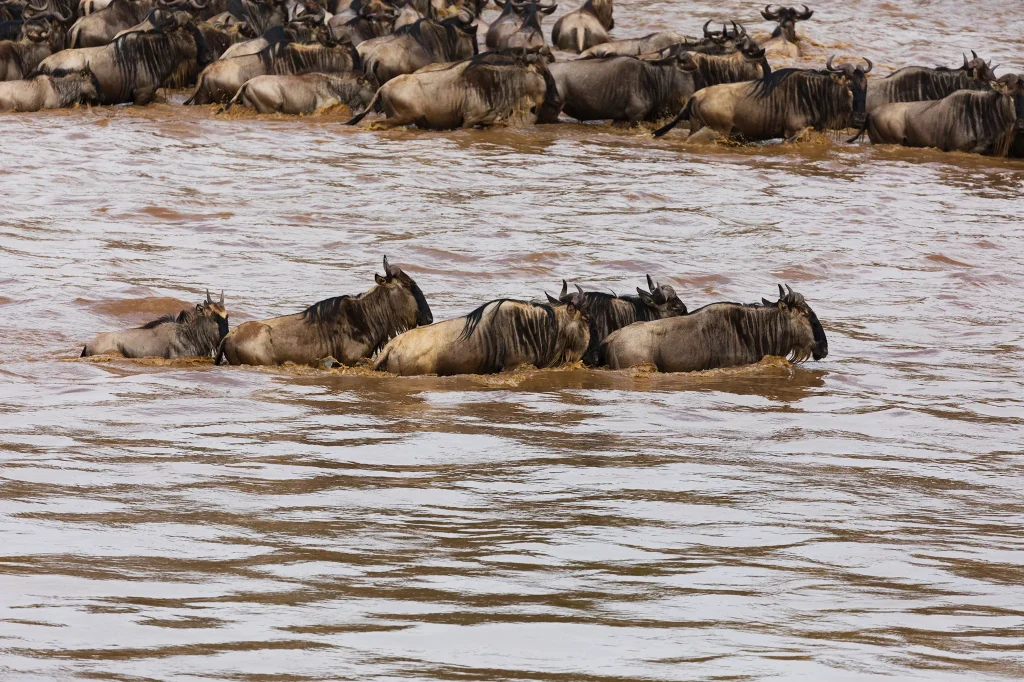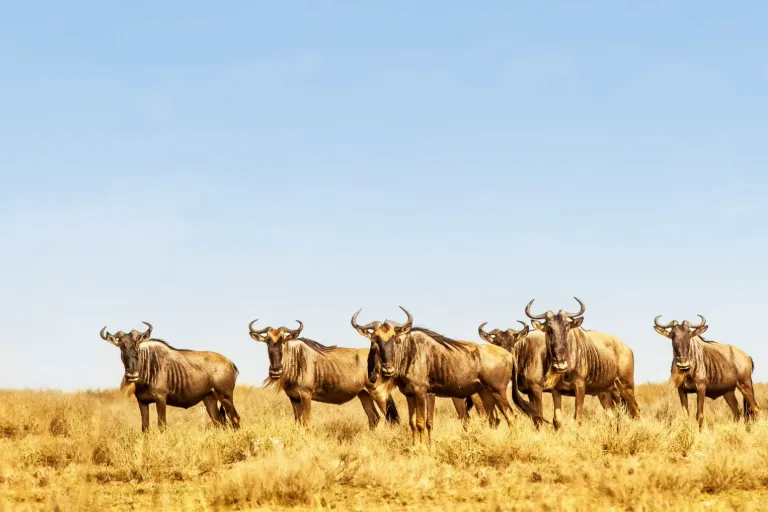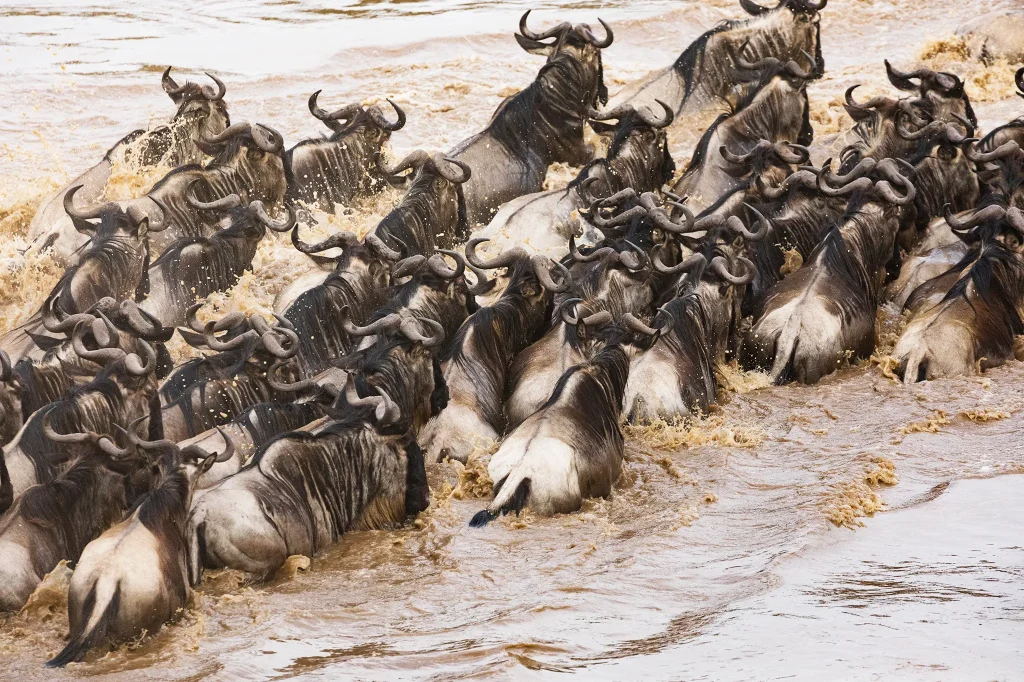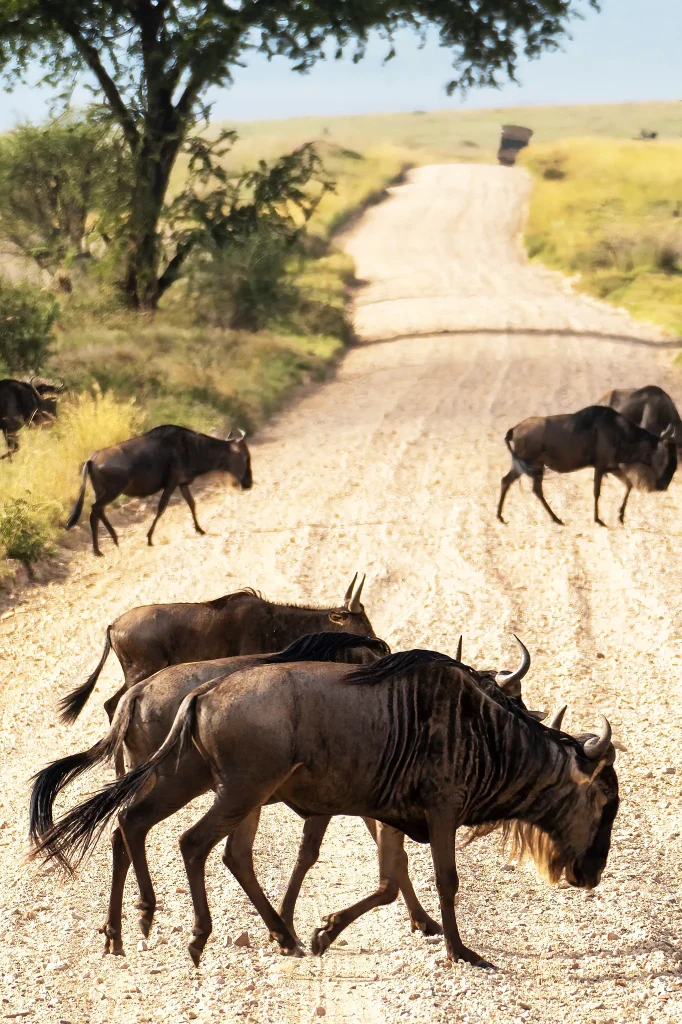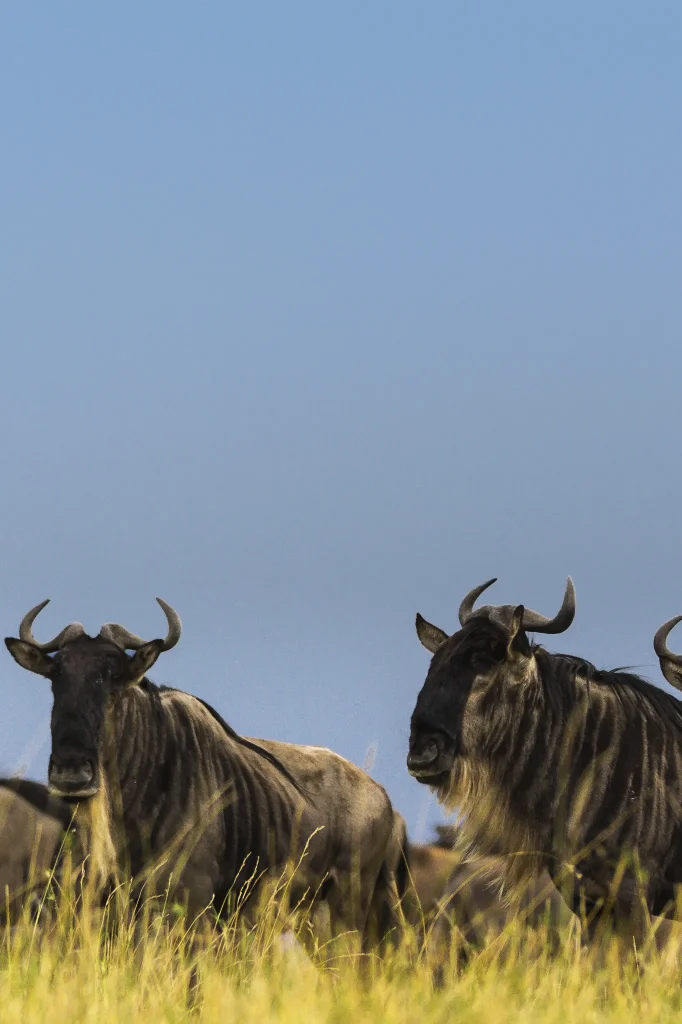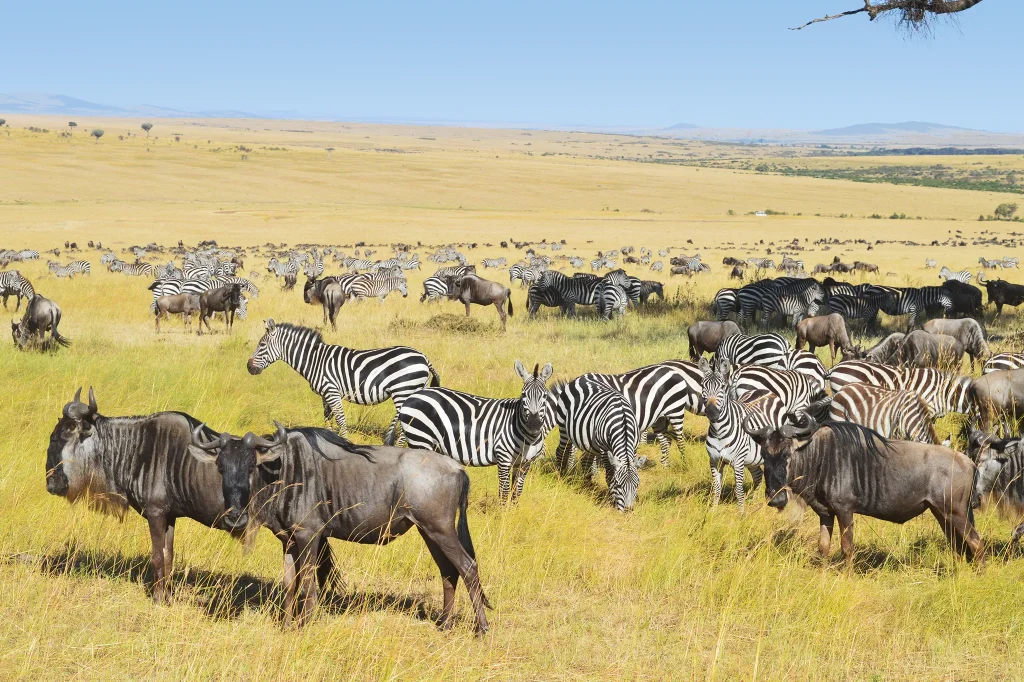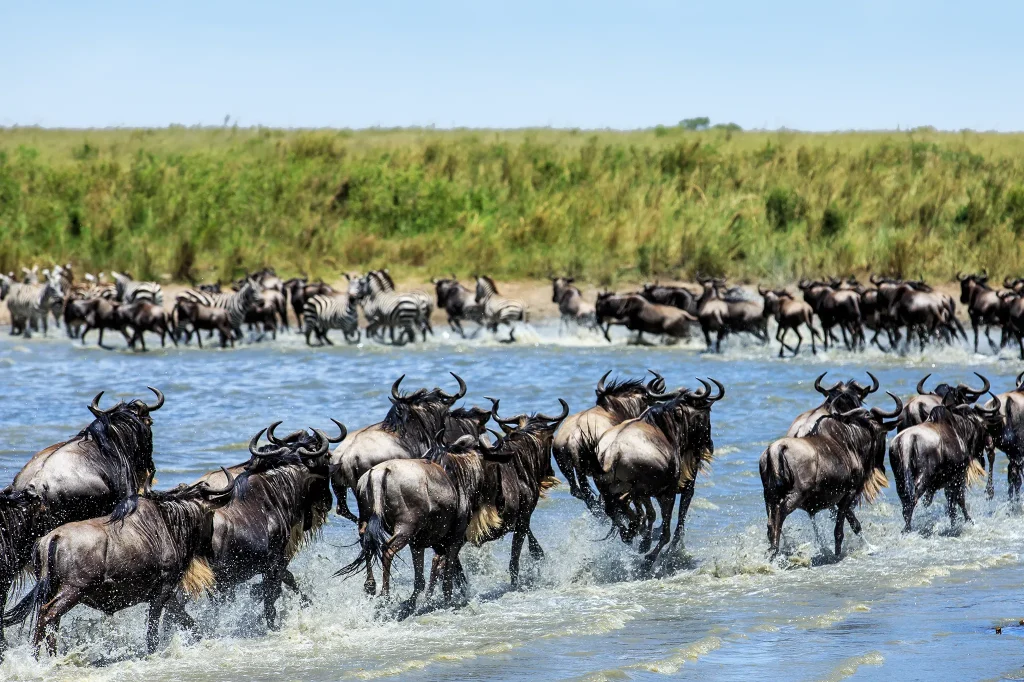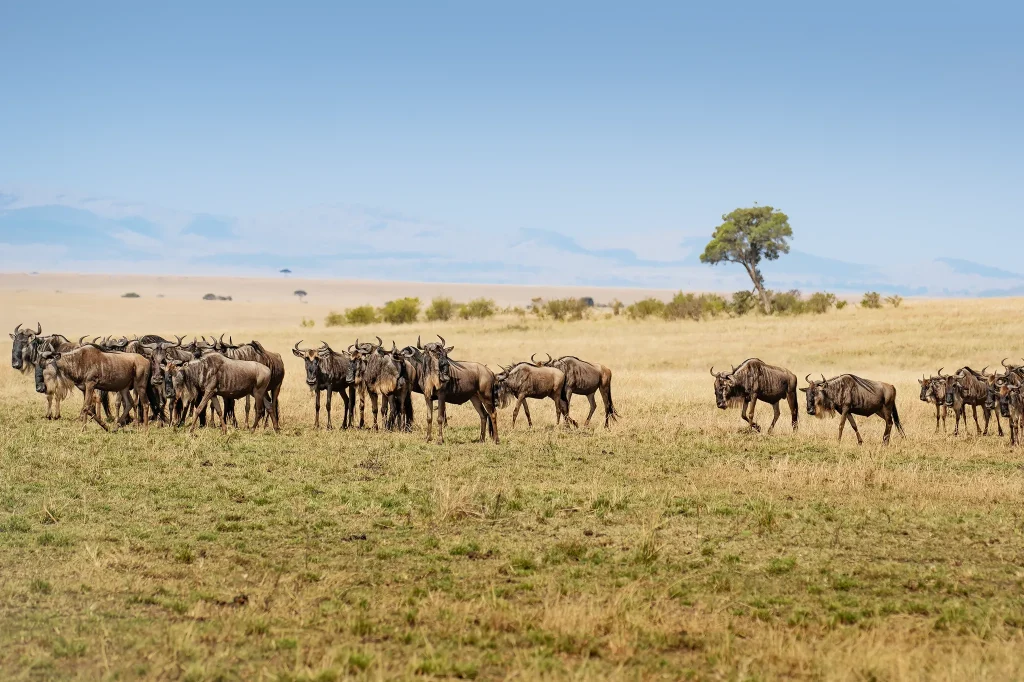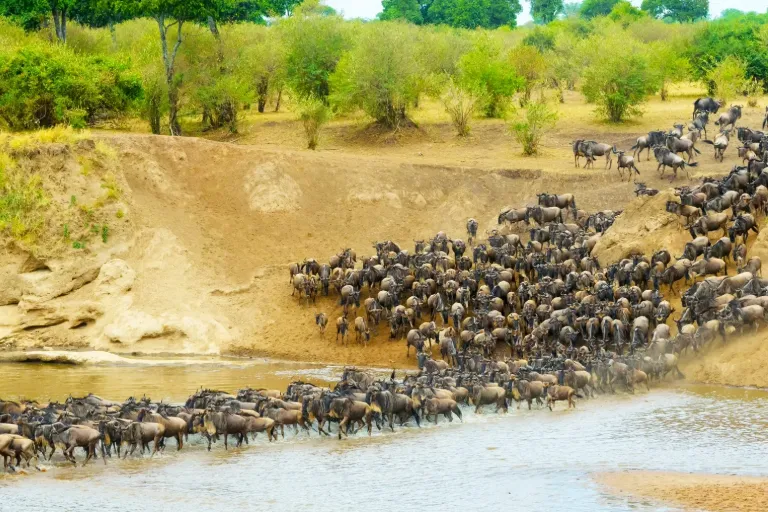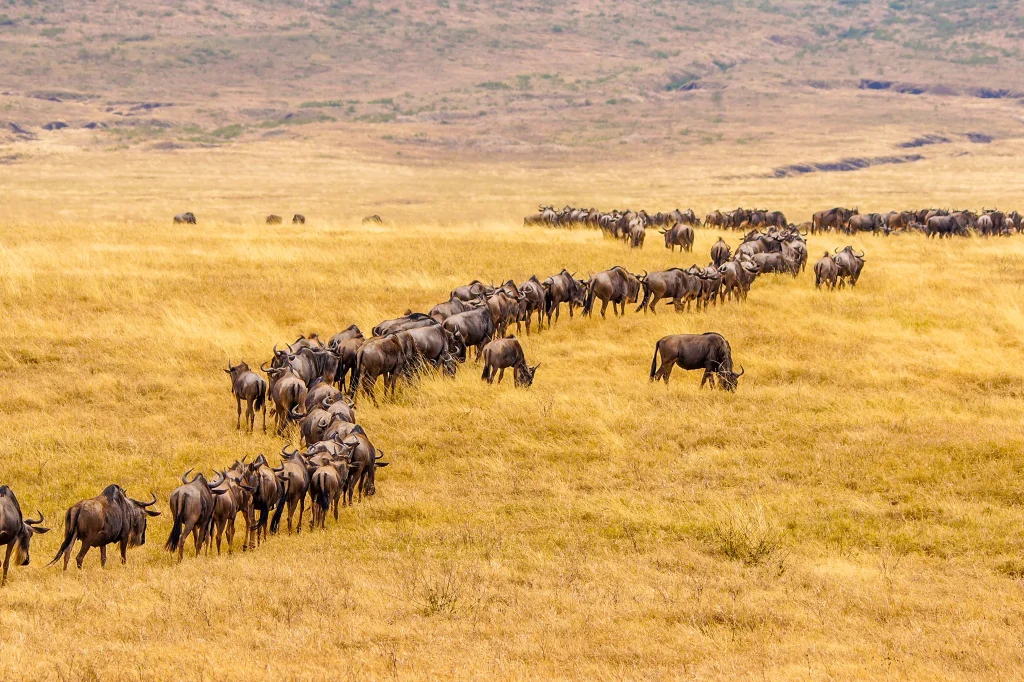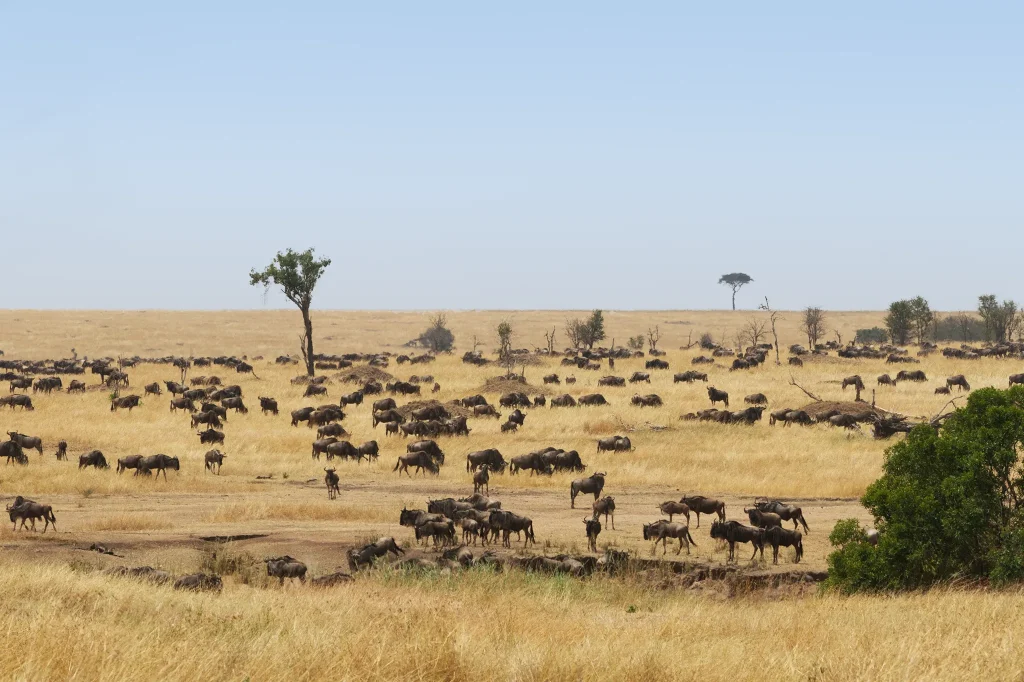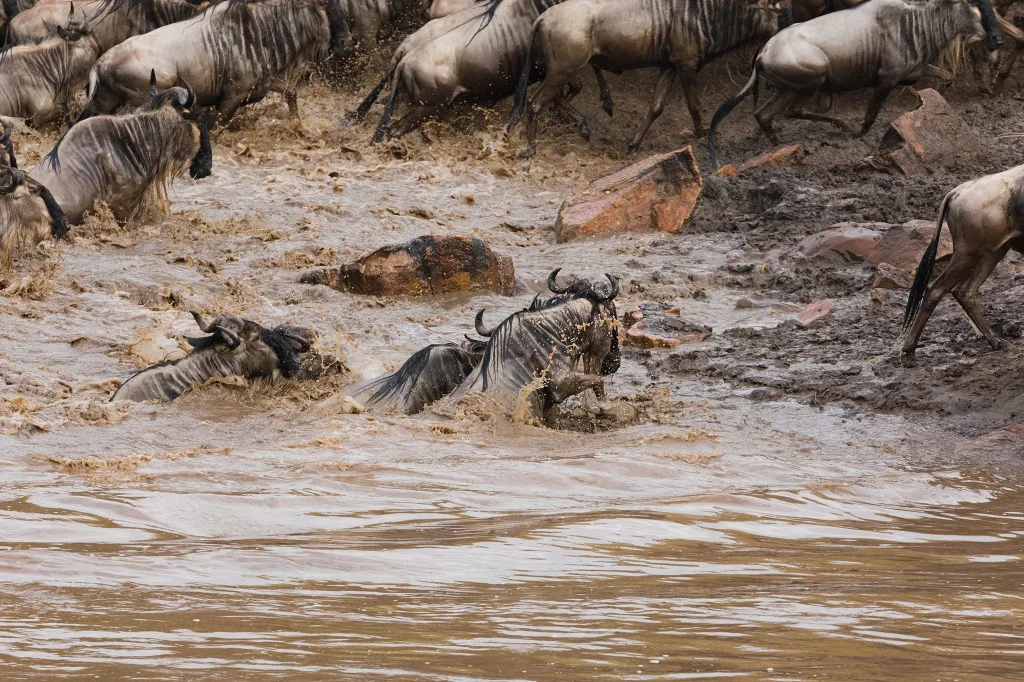Begin your journey into the wild with a Serengeti Safari, where every path reveals the wonders of Africa’s diverse wildlife in its natural habitat. The Serengeti, known for its vast landscapes and the famous wildebeest migration, is home to an incredible variety of Animals in Serengeti.
Here, you can see the majestic Big Five – lions, elephants, rhinos, leopards, and buffaloes – and many more creatures like cheetahs, giraffes, hippos, and zebras. With almost 90 different species of mammals and countless birds, the Serengeti in Tanzania offers a wildlife experience like no other, full of surprises and relishing moments.
The Big Five Icons of the African Wilderness
Let’s take a look at Africa’s Big Five that embrace Serengeti’s endless plains with their dominance.
Lions- The King of the Jungle
In the vast plains of the Serengeti, lions reign supreme. These majestic cats, symbols of strength and courage, are often found resting in the shade or overseeing their territory atop a kopje. Witnessing a lion’s pride in their natural habitat, especially during a hunt, is a highlight of any Serengeti Safari.
Leopards- Elusive Beauty
Leopards, with their exquisite spotted coats and graceful demeanour, are a rare sight, adding to their charm. The Serengeti’s trees often host these solitary predators, lounging on branches or nurturing their young. Spotting a leopard, especially a mother with cubs, is a treasured moment on a Serengeti Safari Tour.
Elephants-Gentle Giants
The African elephant, the largest land mammal, is a magnificent sight. These gentle giants, known for their intelligence and strong family bonds, roam the Serengeti in herds, led by a matriarch. Observing their social interactions on Serengeti Vacation provides a deeper understanding of these complex creatures.
Buffaloes-The Stoic Beasts
Buffaloes, with their formidable horns and herding instinct, are a symbol of communal strength. They are often seen grazing in the grasslands or cooling off in muddy pools. A buffalo herd on the move, with its young and protectors, is a testament to the resilience of Serengeti Animals.
Rhinoceros-The Prehistoric Survivors
Rhinoceros, with their armour-like skin and majestic horns, are a rare sight, making them a prized sighting on any Big Five Safari in Tanzania. The Serengeti’s efforts in conservation have allowed these prehistoric creatures a sanctuary to thrive.
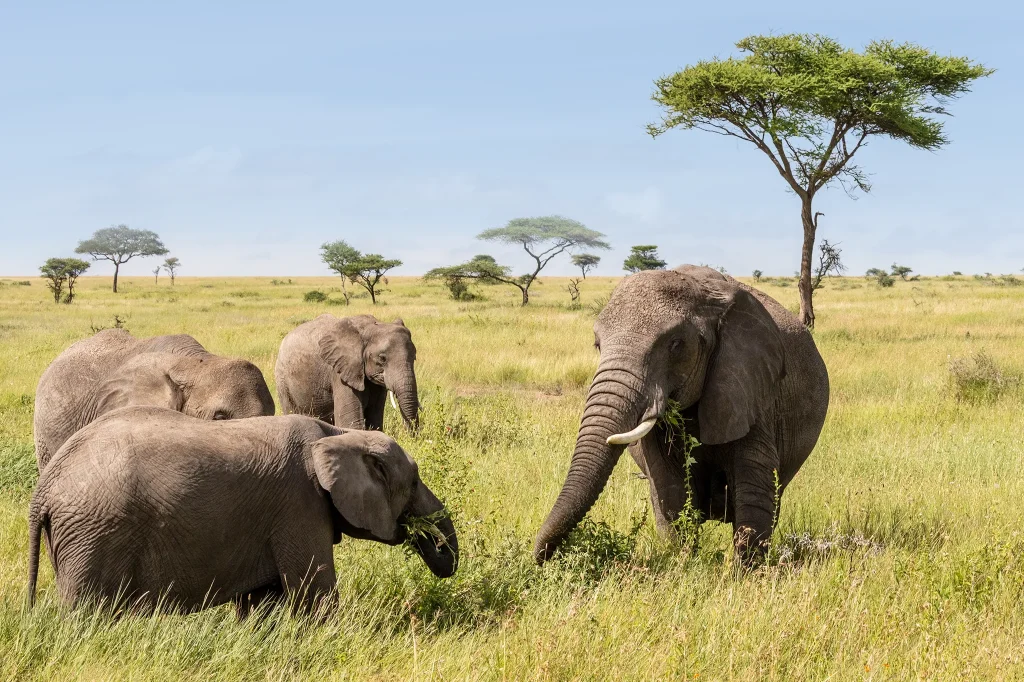
Nature’s most spectacular show – the Great Migration
The Great Wildebeest Migration is a natural marvel. Over two million wildebeests, accompanied by zebras and gazelles, set out on their annual journey across the Serengeti. This migration is driven by the search for fresh grazing lands and water, creating a dynamic wildlife spectacle.
The migration also attracts predators. Lions, hyenas, and crocodiles lie in wait, turning the migration into a struggle for survival. Witnessing a river crossing, where herds brave crocodile-infested waters, is an extremely moving and exhilarating experience.
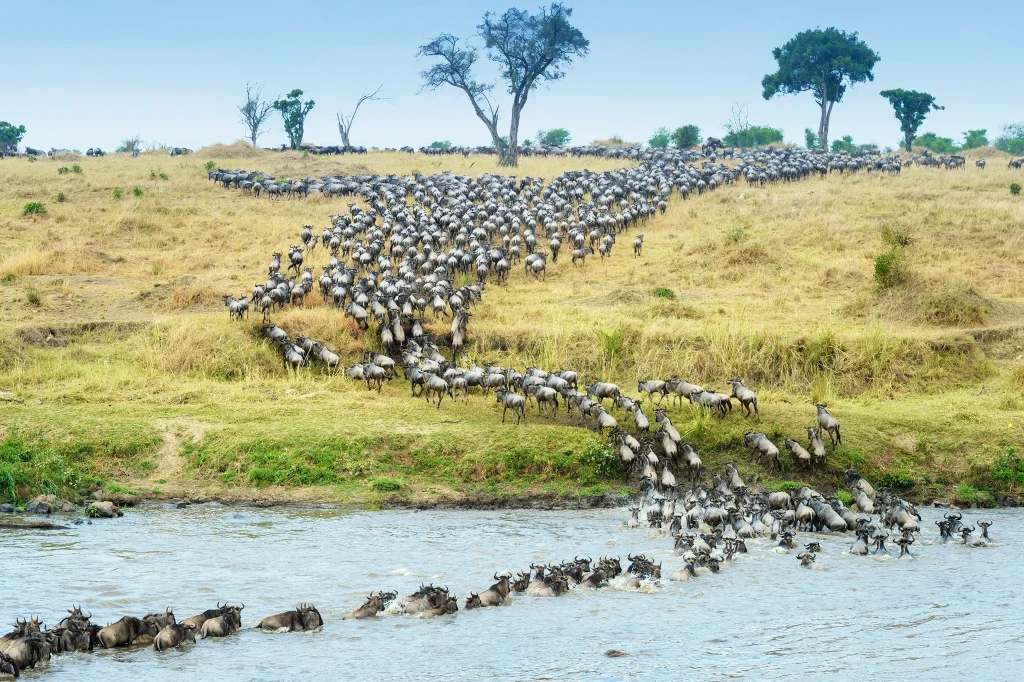
Beyond the Big Five- Serengeti’s Diverse Habitants
Besides being home to the Big Five, Serengeti is also a sanctuary for a multitude of other fascinating mammals which can be explored on Tanzania Safari Packages. From nocturnal animals to agile primates and resilient herbivores the Serengeti offers a captivating glimpse into the diversity of African wildlife.
| Animals | Description | Habitat in Serengeti |
| Aardvark | Nocturnal, burrowing mammals, feeding primarily on ants and termites. | Grasslands, woodlands |
| Aardwolf | Insectivorous and solitary, resembling a small hyena with distinctive stripes. | Open grassy plains |
| Antelope (Various) | Including species like Dik-Dik, Klipspringer, and Oribi, showcasing diversity in size and behaviour. | Arid regions, scrublands |
| Kirk’s Dik-Dik | Small and monogamous antelopes are known for their shy nature and distinct facial markings. | Dry savannas, shrublands |
| Klipspringer | Small antelopes adapted to rocky terrains, known for their ‘tip-toe’ stance. | Rocky outcrops, grasslands |
| Olive Baboon | Social primates live in large troops, adaptable to various habitats. | Savannahs, steppes, forests |
| Oribi | Slender antelopes, prefer open grasslands and are known for their gentle behaviour. | Grasslands, fire-maintained areas |
| Pangolin | Unique, scale-covered mammals, primarily feed on ants and termites. | Woodlands, grasslands |
| Side-Striped Jackal | Omnivorous canids with distinct markings, less predatory than other jackals. | Woodlands, scrublands |
| Slender Mongoose | Solitary and adaptable carnivores, with a varied diet including insects and small vertebrates. | Savannahs, woodlands |
| Spotted Hyena | Social and successful predators are known for their complex social structure and scavenging habits. | Grasslands, woodlands |
| Spring Hare | Nocturnal and hopping rodents feed mainly on grasses and plants. | Grasslands, near burrows |
| Warthog | Common and distinctive wild pigs, known for their erect tails and foraging habits. | Savannahs, semi-arid areas |
| Waterbuck | Large antelopes with shaggy coats are typically found near water sources. | Near water, grasslands |
| Wildebeest | Key players in the Great Migration, these antelopes are known for their herding behaviour and resilience. | Open woodlands, grassy plains |
Avian Wonders of Serengeti
The Serengeti National Park is a paradise for bird enthusiasts. With over 500 bird species, the park offers a spectacular avian display, making it a prime location for Tanzania Birding Safaris. From majestic raptors soaring in the sky to colourful songbirds in the bush, the Serengeti’s birdlife is as diverse as it is fascinating.
| Bird Species | Highlights | Common Habitats in Serengeti |
| Abdim’s Stork | Small stork is known for its grey legs and red facial skin, often seen around water. | Wetlands, grassy plains |
| African Darter | Slim, cormorant-like bird, adept at spearing fish in water bodies. | Lakes, rivers |
| African Grey Hornbill | Smaller hornbill species, feeding on insects and fruits, are commonly found in trees. | Woodlands, savannahs |
| African Fish Eagle | Majestic eagle, recognizable by its white head and powerful build, hunting near water. | Near water bodies |
| African Harrier Hawk | Medium-sized raptor with pale grey colouring and a distinctive hunting style. | Woodlands, urban areas |
| African Openbill | Stork species feeding on aquatic snails, notable for its uniquely shaped bill. | Wetlands, marshes |
| African Spoonbill | A wading bird with a distinctive spoon-shaped bill feeds on aquatic organisms. | Wetlands, lakes |
| African White-backed Vulture | The most common large vulture in Africa is a key player in the ecosystem. | Across the park |
| Bateleur Eagle | Colourful, medium-sized eagle with a short tail, often seen gliding over open areas. | Open woodlands, savannahs |
| Black-chested Snake Eagle | Specialized raptor preying on reptiles, identifiable by its dark chest. | Open lands, savannahs |
| Black-headed Heron | Large wading bird, predominantly grey with a powerful bill, common in grasslands. | Grasslands, wetlands |
| Black-winged Kite | Small, diurnal bird of prey, often seen hovering in open grasslands. | Grasslands, open fields |
| Coqui Francolin | Ground-dwelling bird, widespread across southern Africa, is known for its distinct call. | Grasslands, savannahs |
| Egyptian Goose | Common waterfowl, part of the shelduck family, are often seen in pairs. | Lakes, rivers |
Why Choose African Scenic Safaris?
In the vast expanses of Tanzania, each Serengeti Safari unfolds a unique story. It reveals the majesty of the Animals in Serengeti. This Tanzania Safari Experience goes beyond witnessing the great wildebeest migration or observing live predation; it’s about embracing the essence of the wild.
Eager to witness these natural wonders for yourself? Join African Scenic Safaris on a wild trip to the Serengeti. Book your safari today and prepare to be amazed by the wonders of Tanzania’s most famous national park.



